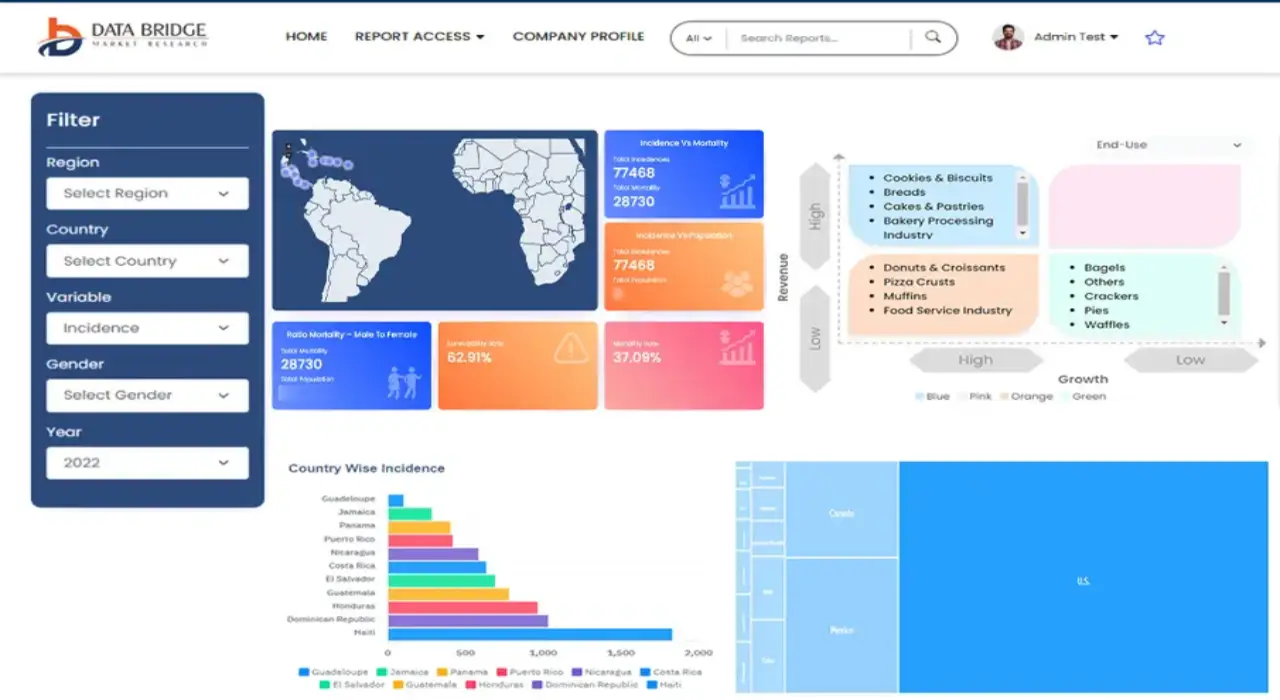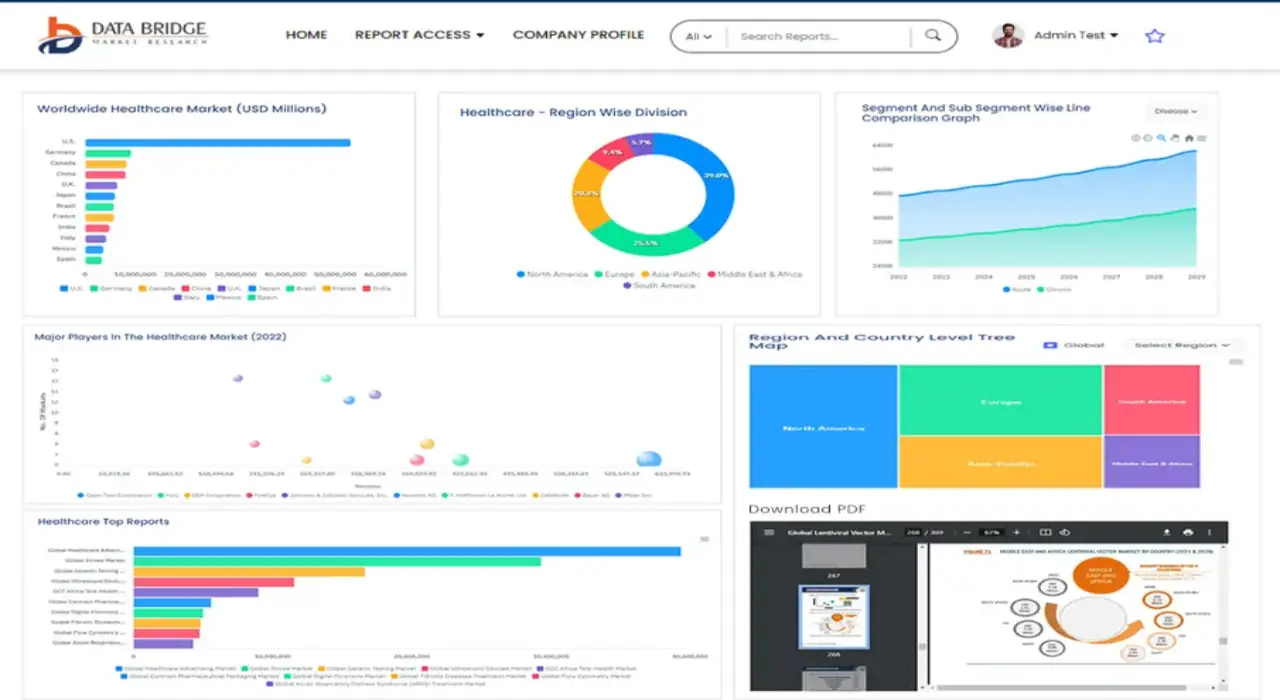Global 4d Printing In Healthcare Market
시장 규모 (USD 10억)
연평균 성장률 :
% 
 USD
45.43 Billion
USD
333.32 Billion
2024
2032
USD
45.43 Billion
USD
333.32 Billion
2024
2032
| 2025 –2032 | |
| USD 45.43 Billion | |
| USD 333.32 Billion | |
|
|
|
>Global 4-Dimensional Printing in Healthcare Market Segmentation, By Component (Equipment, Programmable Material, and Software and Services), Technology (Fusion Deposition Modelling (FDM), Poly Jet, Stereo lithography and Selective Laser Sintering (SLS)), Application (Medical Models, Surgical Guides and Patient-Specific Implants), End User (Hospitals and Clinics, Dental Laboratories, Ambulatory Surgical Centres and Others) – Industry Trends and Forecast to 2032
4-Dimensional Printing in Healthcare Market Analysis
4-dimensional (4D) printing in healthcare is a rapidly evolving field, where materials are designed to change their shape or properties in response to external stimuli, such as temperature, pH, or moisture. This technology builds upon 3D printing by adding the element of time, creating adaptive, dynamic structures that can respond to their environment.
One of the key advancements in 4D printing for healthcare is the development of bio-responsive materials, such as hydrogels and smart polymers that can be used for applications such as drug delivery systems, tissue engineering, and implants. For instance, 4D-printed scaffolds for tissue regeneration can adjust their shape and size based on environmental factors, improving patient-specific treatments.
The growth of this market is driven by the increasing demand for personalized medicine and regenerative therapies. 4D printing allows for precise customization, enhancing treatment efficacy and minimizing side effects. With advancements in material science and printing techniques, the healthcare industry is witnessing a surge in innovative applications, such as self-assembling devices, prosthetics, and surgical instruments, poised to revolutionize patient care.
4-Dimensional Printing in Healthcare Market Size
The global 4-dimensional printing in healthcare market size was valued at USD 45.43 billion in 2024 and is projected to reach USD 333.32 billion by 2032, with a CAGR of 28.29% during the forecast period of 2025 to 2032. In addition to the insights on market scenarios such as market value, growth rate, segmentation, geographical coverage, and major players, the market reports curated by the Data Bridge Market Research also include depth expert analysis, patient epidemiology, pipeline analysis, pricing analysis, and regulatory framework.
4-Dimensional Printing in Healthcare Market Trends
“Growing Use of 4D Bioprinting for Personalized Healthcare Solutions”
One specific trend driving the growth of the 4-dimensional (4D) printing market in healthcare is the increasing use of 4D bioprinting for personalized healthcare solutions. 4D bioprinting involves printing structures that can change shape or properties over time in response to external stimuli, such as temperature or moisture. This innovation has significant potential in creating customized implants, prosthetics, and even tissues that adapt to patients' specific needs. For instance, researchers at the University of Bristol have developed 4D-printed bone implants that reshape within the body, offering greater functionality and promoting healing. This technology’s ability to offer tailored treatments is fueling the market's growth.
Report Scope and 4-Dimensional Printing in Healthcare Market Segmentation
|
Attributes |
4-Dimensional Printing in Healthcare Key Market Insights |
|
Segments Covered |
|
|
Countries Covered |
U.S., Canada and Mexico in North America, Germany, France, U.K., Netherlands, Switzerland, Belgium, Russia, Italy, Spain, Turkey, Rest of Europe in Europe, China, Japan, India, South Korea, Singapore, Malaysia, Australia, Thailand, Indonesia, Philippines, Rest of Asia-Pacific (APAC) in the Asia-Pacific (APAC), Saudi Arabia, U.A.E, South Africa, Egypt, Israel, Rest of Middle East and Africa (MEA) as a part of Middle East and Africa (MEA), Brazil, Argentina and Rest of South America as part of South America |
|
Key Market Players |
3D Systems, Inc. (U.S.), Organovo Holdings Inc. (U.S.), Stratasys Ltd. (U.S.), Materialise (Belgium), Proto Labs (U.S.), ExOne (U.S.), SLM Solutions (Germany), Voxeljet AG (Germany), Dassault Systèmes (France), EOS GmbH Electro Optical Systems (Germany), EnvisionTEC (U.S.), Optomec, Inc. (U.S.), Poietis - 4D Bioprinting (France), Allevi, Inc. (U.S.), Tractus3D (Netherlands), 3D HUBS B.V. (Netherlands), Axial3D - Medical 3D Printing Experts Ltd. (U.K.), Formlabs (U.S.), and CELLINK GLOBAL (Sweden) |
|
Market Opportunities |
|
|
Value Added Data Infosets |
In addition to the insights on market scenarios such as market value, growth rate, segmentation, geographical coverage, and major players, the market reports curated by the Data Bridge Market Research also include depth expert analysis, patient epidemiology, pipeline analysis, pricing analysis, and regulatory framework. |
4-Dimensional Printing in Healthcare Market Definition
4-dimensional (4D) printing in healthcare refers to the use of 3D printing technologies combined with materials that can change shape or behavior over time in response to external stimuli, such as temperature, moisture, or light. This innovation enables the creation of dynamic medical devices, prosthetics, and implants that can adapt to the body’s needs. For instance, 4D-printed scaffolds in tissue engineering can transform to mimic natural tissue growth or aid in healing. The technology has the potential to revolutionize personalized medicine, enabling more effective, responsive healthcare solutions tailored to individual patient conditions and treatments.
4-Dimensional Printing in Healthcare Market Dynamics
Drivers
- Enhanced Drug Delivery Systems
4D printing is revolutionizing drug delivery systems by enabling the creation of responsive materials that change shape or release medication at specific times or in response to environmental factors such as pH or temperature. For instance, researchers are developing 4D-printed implants that can gradually release drugs over an extended period, reducing the need for frequent dosing. A notable instance is the development of 4D-printed hydrogels that adapt to the body’s conditions, providing targeted and controlled drug release for chronic conditions such as cancer or diabetes. This innovation not only enhances treatment efficacy but also minimizes side effects, making drug delivery more efficient, personalized, and patient-friendly, thereby driving growth in the healthcare market.
- Wearable Healthcare Devices
4D printing plays a crucial role in advancing wearable devices by creating smart, flexible, and functional products that adapt to the wearer’s body and health conditions. These devices, such as smart bandages and biosensors, can continuously monitor vital signs such as heart rate, blood pressure, and glucose levels, providing real-time health data. For instance, researchers are developing 4D-printed wearable patches that can change shape in response to temperature or pressure, improving comfort and accuracy in monitoring. This adaptability enhances patient care by offering personalized, non-invasive solutions that can track chronic conditions, detect early signs of health issues, and improve overall health management, thus driving market growth in healthcare technology.
Opportunities
- Rising Minimally Invasive Procedures
The demand for minimally invasive procedures in healthcare is driving significant opportunities for 4D printing technology. 4D-printed implants and devices that can change shape within the body reduce the need for large incisions and complex surgeries, promoting quicker recovery times. For instance, 4D-printed stents and scaffolds are designed to adapt to the patient’s anatomy once implanted, providing better functionality without the need for additional surgeries. This adaptability leads to less trauma, reduced infection risks, and shorter hospital stays. The growing emphasis on reducing recovery times and healthcare costs is encouraging investment in 4D printing, positioning it as a crucial tool in the evolution of less invasive medical treatments.
- Customization of Medical Devices
4D printing creates significant opportunities in the healthcare market by enabling the production of patient-specific implants and prosthetics. Different from traditional methods, 4D printing allows for the creation of devices that can adapt to a patient's changing body conditions over time, ensuring a more precise fit and improved functionality. For instance, custom 4D-printed orthopedic implants can adjust to the patient’s bone growth, promoting faster healing and reducing complications. Similarly, prosthetics can evolve based on a patient’s physical activity and comfort, offering a dynamic solution. This level of customization enhances patient outcomes, fosters greater adoption, and drives market growth, as demand for personalized healthcare solutions increases.
Restraints/Challenges
- High Cost of Materials and Equipment
The high cost of materials and equipment for 4-dimensional (4D) printing in healthcare significantly hinders market growth. Specialized materials, such as smart polymers that change shape in response to external stimuli, and advanced 3D printers capable of handling these materials are expensive. The need for highly customized equipment further drives up costs, making it difficult for healthcare providers, especially in resource-constrained regions, to adopt this technology. As a result, the high upfront investment in 4D printing technology limits its accessibility and adoption, particularly in developing countries. This financial barrier restricts the potential applications of 4D printing in areas such as personalized implants and tissue engineering, slowing overall market expansion.
- Limited Material Options
Limited material options hinder the growth of the 4D printing market in healthcare. Currently, there are only a few materials that possess the required properties such as biocompatibility, durability, and responsiveness to environmental changes. This limitation restricts the ability to create safe and effective medical devices or implants that can adapt to the human body's conditions over time. As a result, healthcare professionals face challenges in using 4D-printed products for patient-specific solutions, leading to a slower adoption rate. The lack of diverse, reliable materials not only restricts the development of innovative applications but also raises concerns regarding the long-term performance and safety of 4D-printed healthcare devices.
This market report provides details of new recent developments, trade regulations, import-export analysis, production analysis, value chain optimization, market share, impact of domestic and localized market players, analyses opportunities in terms of emerging revenue pockets, changes in market regulations, strategic market growth analysis, market size, category market growths, application niches and dominance, product approvals, product launches, geographic expansions, technological innovations in the market. To gain more info on the market contact Data Bridge Market Research for an Analyst Brief, our team will help you take an informed market decision to achieve market growth.
4-Dimensional Printing in Healthcare Market Scope
The market is segmented on the basis of component, technology, application, and end user. The growth amongst these segments will help you analyze meagre growth segments in the industries and provide the users with a valuable market overview and market insights to help them make strategic decisions for identifying core market applications.
Component
- Equipment
- 3D Printers
- 3D Bioprinters
- Programmable Material
- Shape-memory Materials
- Hydrogels
- Living cells
- Software and Services
Technology
- Fusion Deposition Modelling (FDM)
- Poly Jet
- Stereo lithography
- Selective Laser Sintering (SLS)
Application
- Medical Models
- Surgical Guides
- Patient-Specific Implants
End User
- Hospitals and Clinics
- Dental Laboratories
- Ambulatory Surgical Centres
- Others
4-Dimensional Printing in Healthcare Market Regional Analysis
The market is analysed and market size insights and trends are provided by country, component, technology, application, and end user as referenced above.
The countries covered in the market report are U.S., Canada, Mexico in North America, Germany, Sweden, Poland, Denmark, Italy, U.K., France, Spain, Netherland, Belgium, Switzerland, Turkey, Russia, Rest of Europe in Europe, Japan, China, India, South Korea, New Zealand, Vietnam, Australia, Singapore, Malaysia, Thailand, Indonesia, Philippines, Rest of Asia-Pacific (APAC) in Asia-Pacific (APAC), Brazil, Argentina, Rest of South America as a part of South America, U.A.E, Saudi Arabia, Oman, Qatar, Kuwait, South Africa, Rest of Middle East and Africa (MEA) as a part of Middle East and Africa (MEA)
North America is expected to dominate the 4-dimensional printing in healthcare market in terms of market share and market revenue and will continue to flourish its dominance during the forecast period. This is because of the prevailing sophisticated level of healthcare facilities, increasing expenditure for research and development activities, and surge in the cases of organ transplantation.
Asia-Pacific on the other hand is projected to exhibit the highest growth rate during the forecast period owing to the large patient pool, increased expenditure on healthcare infrastructure by public and private agencies and increasing personal disposable.
The country section of the report also provides individual market impacting factors and changes in regulation in the market domestically that impacts the current and future trends of the market. Data points such as down-stream and upstream value chain analysis, technical trends and porter's five forces analysis, case studies are some of the pointers used to forecast the market scenario for individual countries. Also, the presence and availability of global brands and their challenges faced due to large or scarce competition from local and domestic brands, impact of domestic tariffs and trade routes are considered while providing forecast analysis of the country data.
4-Dimensional Printing in Healthcare Market Share
The market competitive landscape provides details by competitor. Details included are company overview, company financials, revenue generated, market potential, investment in research and development, new market initiatives, global presence, production sites and facilities, production capacities, company strengths and weaknesses, product launch, product width and breadth, application dominance. The above data points provided are only related to the companies' focus related to market.
4-Dimensional Printing in Healthcare Market Leaders Operating in the Market Are:
- 3D Systems, Inc. (U.S.)
- Organovo Holdings Inc. (U.S.)
- Stratasys Ltd. (U.S.)
- Materialise (Belgium)
- Proto Labs (U.S.)
- ExOne (U.S.)
- SLM Solutions (Germany)
- Voxeljet AG (Germany)
- Dassault Systèmes (France)
- EOS GmbH Electro Optical Systems (Germany)
- EnvisionTEC (U.S.)
- Optomec, Inc. (U.S.)
- Poietis - 4D Bioprinting (France)
- Allevi, Inc. (U.S.)
- Tractus3D (Netherlands)
- 3D HUBS B.V. (Netherlands)
- Axial3D - Medical 3D Printing Experts Ltd. (U.K.)
- Formlabs (U.S.)
- CELLINK GLOBAL (Sweden)
Latest Developments in 4-Dimensional Printing in Healthcare Market
- In September 2024, A medtech start-up is transforming orthopedic care by incorporating 4D printing technology to produce adaptive implants and braces that self-adjust. This innovative approach is designed to enhance patient outcomes by creating personalized solutions that evolve with the body’s needs. The integration of 4D printing is setting a new standard for customized healthcare, showcasing its growing influence in improving treatment efficacy and patient care in the medical field
- In May 2021, ROKIT Healthcare announced the launch of an advanced anti-aging wellness facility in Hungary, marking a significant step in the integration of cutting-edge technologies in regenerative medicine. The facility aims to combine 4D bioprinting, single-cell RNA analysis, and intelligence-based anti-aging products to offer personalized services. This approach emphasizes individualized regenerative treatments, aiming to revolutionize the anti-aging market by providing tailored healthcare solutions that promote long-term wellness and vitality
SKU-
세계 최초의 시장 정보 클라우드 보고서에 온라인으로 접속하세요
- 대화형 데이터 분석 대시보드
- 높은 성장 잠재력 기회를 위한 회사 분석 대시보드
- 사용자 정의 및 질의를 위한 리서치 분석가 액세스
- 대화형 대시보드를 통한 경쟁자 분석
- 최신 뉴스, 업데이트 및 추세 분석
- 포괄적인 경쟁자 추적을 위한 벤치마크 분석의 힘 활용
연구 방법론
데이터 수집 및 기준 연도 분석은 대규모 샘플 크기의 데이터 수집 모듈을 사용하여 수행됩니다. 이 단계에는 다양한 소스와 전략을 통해 시장 정보 또는 관련 데이터를 얻는 것이 포함됩니다. 여기에는 과거에 수집한 모든 데이터를 미리 검토하고 계획하는 것이 포함됩니다. 또한 다양한 정보 소스에서 발견되는 정보 불일치를 검토하는 것도 포함됩니다. 시장 데이터는 시장 통계 및 일관된 모델을 사용하여 분석하고 추정합니다. 또한 시장 점유율 분석 및 주요 추세 분석은 시장 보고서의 주요 성공 요인입니다. 자세한 내용은 분석가에게 전화를 요청하거나 문의 사항을 드롭하세요.
DBMR 연구팀에서 사용하는 주요 연구 방법론은 데이터 마이닝, 시장에 대한 데이터 변수의 영향 분석 및 주요(산업 전문가) 검증을 포함하는 데이터 삼각 측량입니다. 데이터 모델에는 공급업체 포지셔닝 그리드, 시장 타임라인 분석, 시장 개요 및 가이드, 회사 포지셔닝 그리드, 특허 분석, 가격 분석, 회사 시장 점유율 분석, 측정 기준, 글로벌 대 지역 및 공급업체 점유율 분석이 포함됩니다. 연구 방법론에 대해 자세히 알아보려면 문의를 통해 업계 전문가에게 문의하세요.
사용자 정의 가능
Data Bridge Market Research는 고급 형성 연구 분야의 선두 주자입니다. 저희는 기존 및 신규 고객에게 목표에 맞는 데이터와 분석을 제공하는 데 자부심을 느낍니다. 보고서는 추가 국가에 대한 시장 이해(국가 목록 요청), 임상 시험 결과 데이터, 문헌 검토, 재생 시장 및 제품 기반 분석을 포함하도록 사용자 정의할 수 있습니다. 기술 기반 분석에서 시장 포트폴리오 전략에 이르기까지 타겟 경쟁업체의 시장 분석을 분석할 수 있습니다. 귀하가 원하는 형식과 데이터 스타일로 필요한 만큼 많은 경쟁자를 추가할 수 있습니다. 저희 분석가 팀은 또한 원시 엑셀 파일 피벗 테이블(팩트북)로 데이터를 제공하거나 보고서에서 사용 가능한 데이터 세트에서 프레젠테이션을 만드는 데 도움을 줄 수 있습니다.















